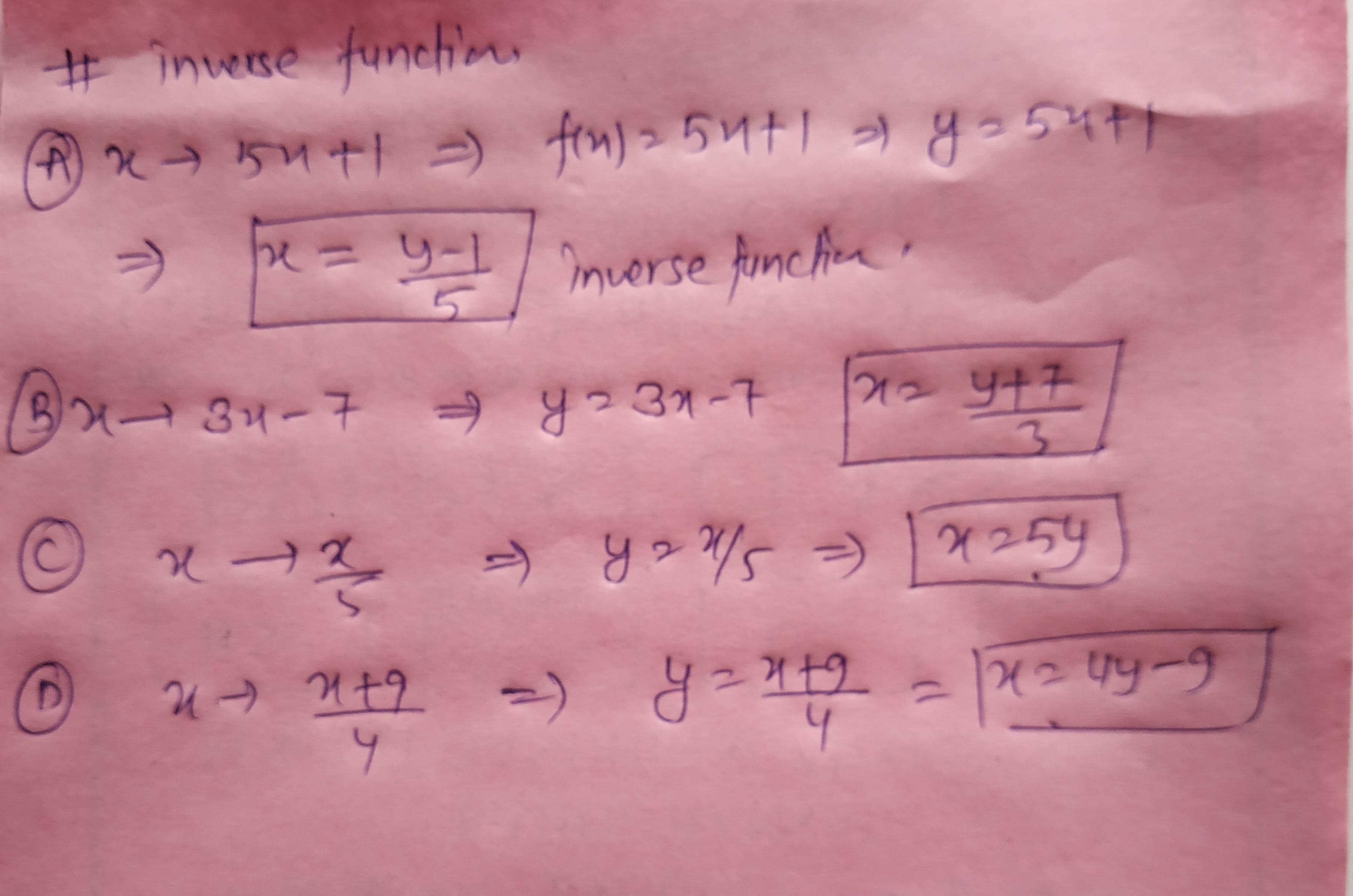Relations And Functions - Class 12 Engineering Maths - Extra Questions
Show that if f:A→B and g:B→C are one-one, then g∘f:A→C is also one-one.
Let f:R→R be defined by f(x)=x3+5 then find f−1(x)
If the function f:[1,∞)→[1,∞) is defined by f(x)=2x(x−1),then find f−1(4)
Let f:R→R be defined as f(s)=10x+7. Find the function g:R→R such that gof=fog=1R
Let f:R→R be defined by f(x)=2x+3, find f−1(4).
Consider f:R−{−43}→R−{43} given by f(x)=4x+33x+4. Show that f is bijective. Find the inverse of f and hence if the value of f−1(0) is A and x is B such that f−1(x)=2, then find (A+B)×100.
If f(x)=(4x+3)(6x−4), x≠23, show that fof(x)=x, for all x≠23. What is the inverse of f?
Let f:N→Y be a function defined as f(x)=4x+3, where, Y={y∈N:y=4x+3 for some x∈N}, Show that f is invertible. Find the inverse.
Let f:N→N be a function defined as f(x)=4x2+12x+15. Show that f:N→S is invertible. Find the inverse of f and hence find f−1(31) and f−1(87) .
Show that f:[−1,1]→R, given by f(x)=x(x+2) is one-one. Find the inverse of the function f:[−1,1]→Range f.
Work out the inverse function for each mapping.
x→5x+1
x→3x−7
x→x5
x→x+94
x→5x+1
x→3x−7
x→x5
x→x+94
Let f be any real function and let g be a function given by g(x)=2x. Prove that g∘f=f+f.
If f:(−π2,π2)→R and g:[−1,1]→R be defined as f(x)=tanx and g(x)=√1−x2 respectively. Describe f∘g and g∘f.
If f(x)=2x+5 and g(x)=x2+1 be two real functions, then describe given functions:
(i) f∘g
(ii) g∘f
(iii) f∘f
(iv) f2
Also, show that f∘f≠f2.
If f(x)=√1−x and g(x)=logex are two real functions, then describe functions f∘g and g∘f.
If f,g:R→R be two functions defined as f(x)=|x|+x and g(x)=|x|−x for all x∈R. Then, find f∘g and g∘f. Hence, find f∘g(−3), f∘g(5) and g∘f(−2).
If f(x)=√x+3 and g(x)=x2+1 be two real functions, then find f∘g and g∘f.
Let A={x∈R|−1≤x≤1} and let f:A→A,g:A→A be two functions defined by f(x)=x2 and g(x)=sinπx2.Show that g−1 exists but f−1 does not exist. Also find g−1.
Let f:→R, g:R→R be two functions defined by f(x)=x2+x+1 and g(x)=1−x2. Write f∘g(−2).
If f:{5,6}→{2,3} and g:{2,3}→{5,6} are given by f={(5,2),(6,3)} and g={(2,5),(3,6)}, find f∘g.
Let f(x) be a continuous and g(x) is a discontinuous function then prove that f(x)+g(x) is discontinuous at x=a
If f is an invertible function, define as f\left ( x \right )=\cfrac{3x-4}{5}, write f^{-1}\left ( x \right ).
If A=\left\{a,b,c,d \right\} and f=\left\{(a,b),(b,d),(c,a),(d,c)\right\}, show that f is one-one from A onto A. Find f^{-1}
Let f:R\to R be the function defined by f(x)=4x-3\forall x\in R. Then write f^{-1}.
Show that f;[-1,1]\rightarrow R, given by f(x)=\dfrac{x}{(x+2)} is one-one. Find the inverse of the function f;[-1,1]\rightarrow Range f.
(Hint: For y\in Range, f, y=f(x)=\dfrac{x}{x+2} for some x in [-1,1]
x=\dfrac{2y}{(1-y)}
Consider f:R\rightarrow R given by f(x)=4x+3. Show that f is invertible. Find the inverse of f.
Consider f : R - \left \{ -\dfrac{4}{3} \right \} \rightarrow R - \left \{ \dfrac{4}{3} \right \} given by f(x) = \dfrac{4x + 3}{3x + 4}. Show that f is
bijective. Find the inverse of f and hence find f^{-1} (0) and x such that f^{-1}(x) = 2.
Prove that the function f : N \to N, defined by f(x) = x^2 + x + 1 is one-one but not onto. Find inverse of f : N \to S, where S is range of f.
Let g be a real valued differentiable function on R such that g(x) = 3e^{x-2}+4\displaystyle\int_{2}^{x}\sqrt{2t^{2}+6t+5}dt \quad\forall x \in R and let g^{-1} be the inverse function of g. If (g^{-1})' (3) is equal to \dfrac{p}{q} where p and q are relatively prime, then find \dfrac{p+q}{6}
Let A = R - \left \{3\right \} and B = R - \left \{1\right \}. Consider the function f: A\rightarrow B defined by f(x) = \left (\dfrac {x - 2}{x - 3}\right ) Show that f is one-one and onto and hence find f^{-1}
Let f be a real function given by f(x)=\sqrt{x-2}. Find the following.
(i) f\circ f (ii) f\circ f\circ f (iii) (f\circ f\circ f)(38) (iv) {f}^{2}
Also, show that f\circ f\ne {f}^{2}.
If f:R\rightarrow R be defined by f(x)={x}^{3}-3, then prove that {f}^{-1} exists and find a formula for {f}^{-1}. Hence, find {f}^{-1}(24) and {f}^{-1}(5).
Let f:N\rightarrow N be a function defined as f(x)=9{x}^{2}+6x-5. Show that f:N\rightarrow S, where S is the range of f, is invertible. Find the inverse of f and hence find {f}^{-1}(43) and {f}^{-1}(163).
Let f(x) =\left\{\begin{matrix} x+a & \text{if} \ x < 0 \\ |x-1| & \text{if} \ x \ge 0 \end{matrix}\right. andg(x) = \left\{\begin{matrix} x+1 & \text{if} \ x < 0\\ (x-1)^2+b & \text{if} \ x \ge 0, \end{matrix}\right.Where a and b are non-negative real number. Determine the composite function g o f. if is continuous for all real x, determine the Values of a and b. Further for these values of a and b is g o f differentiable at x=0? Justify your answer
Class 12 Engineering Maths Extra Questions
- Continuity And Differentiability Extra Questions
- Determinants Extra Questions
- Differential Equations Extra Questions
- Integrals Extra Questions
- Inverse Trigonometric Functions Extra Questions
- Relations And Functions Extra Questions
- Three Dimensional Geometry Extra Questions
- Vector Algebra Extra Questions

